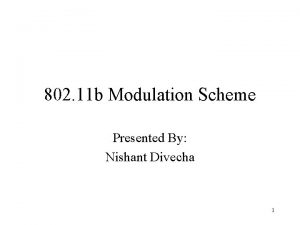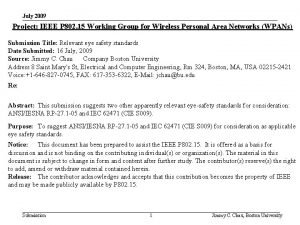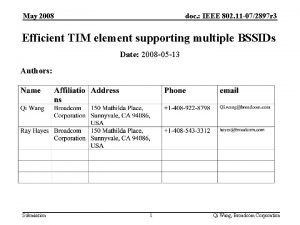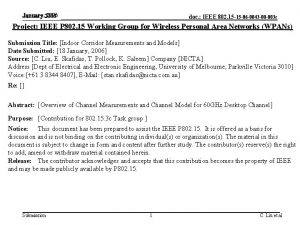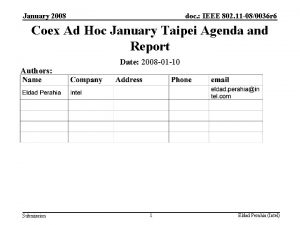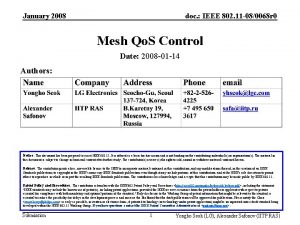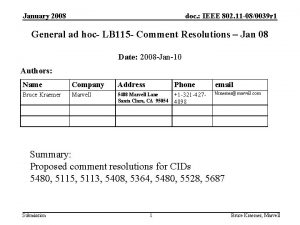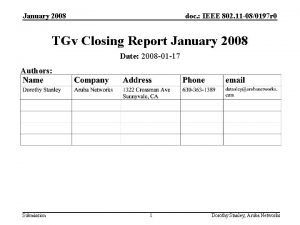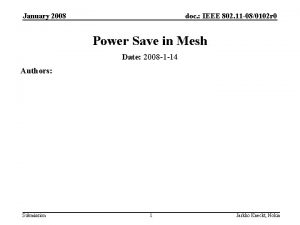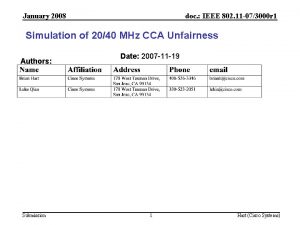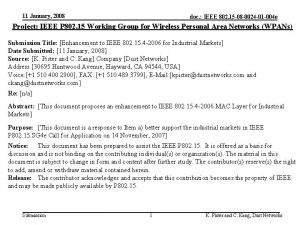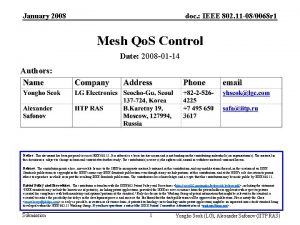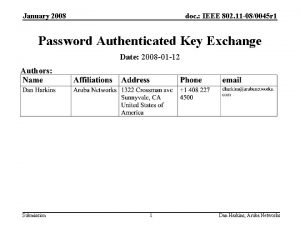January 2008 doc IEEE 802 11 072897 r
















- Slides: 16

January 2008 doc. : IEEE 802. 11 -07/2897 r 2 Efficient TIM element supporting multiple BSSIDs Date: 2008 -01 -15 Authors: Submission 1 Qi Wang, Broadcom Corporation

January 2008 doc. : IEEE 802. 11 -07/2897 r 2 Abstract This presentation proposes an improvement to the TIM element supporting multiple BSSIDs. Compared to the existing method defined in IEEE P 802. 11 v. D 1. 0, the proposed modification reduces the beacon frame size while incurring minimal additional complexity at an AP and no additional complexity at STAs. Submission 2 Qi Wang, Broadcom Corporation

January 2008 doc. : IEEE 802. 11 -07/2897 r 2 Introduction • A modified TIM element supporting multiple BSSIDs is defined in the draft 11 v spec – A single AID space is shared by all stations associated with an AP which supports multiple BSSIDs • AID 0 to AID (2 n-1) are used for buffered broadcast/multicast frame indications • AID 2 n to AID 2007 are assigned to individual stations – A single beacon frame with a single TIM element is used to announce the buffered frames for all stations associated with one of the multiple BSSIDs supported by an AP Submission 3 Qi Wang, Broadcom Corporation

January 2008 doc. : IEEE 802. 11 -07/2897 r 2 Current TIM Element for Multiple BSSIDs (General Case) Contents of the Partial Virtual Bitmap field, and Bitmap. Offset = 0 Octet index 00 Bit index 0 N 2 (2 n-1) (N 2+1) 2007 1 0 Bits values depend on whether the corresponding BSSIDs have broadcast/multicast frames buffered at the AP or not Bits 0 to (2 n-1) indicate buffered broadcast/multicast frames at AP or not Bits values depend on whether the corresponding STAs have unicast frames buffered at the AP or not 0 Values of all bits are 0 s Bits 2 n to 2007 indicate buffered unicast frames at AP or not; Each bit corresponds to one STA Traffic Indication Virtual Bitmap Submission 4 Qi Wang, Broadcom Corporation

January 2008 doc. : IEEE 802. 11 -07/2897 r 2 Current TIM Element for Multiple BSSIDs (Special Case) Contents of the Partial Virtual Bitmap field, and Bitmap. Offset = 0 (Encoded as a single all 0 s octet) 0 0 Octet index Bit index 0 (2 n-1) 2007 0 0 Values of all bits are 0 s Bits 0 to (2 n-1) indicate buffered broadcast/multicast frames at AP or not Values of all bits are 0 s 1 Bits 2 n to 2007 indicate buffered unicast frames at AP or not; Each bit corresponds to one STA Traffic Indication Virtual Bitmap Submission 5 Qi Wang, Broadcom Corporation

January 2008 doc. : IEEE 802. 11 -07/2897 r 2 Inefficiency of Current TIM Element • The current PVB encoding method of the TIM element is designed to be backwards compatible with legacy STAs at the cost of potentially always sending a long string of zero bits • However, there are situations where a more efficient PVB encoding method is possible without incurring misinterpretation by the STAs – Example: no legacy STAs in the BSS – Example: bits 0 to (2 n-1) of the Traffic Indication Virtual Bitmap are all 0 s – Example: The AP knows all legacy STAs cannot wrongly interpret the Partial Virtual Bitmap. • That is, when legacy STAs prepend 2 x. Bitmap_Offset octets all 0 bits before octet 0 of the Partial Virtual Bitmap generated using a new method (i. e. , Method B) to form a “Modified Partial Virtual Bitmap”, none of the legacy STAs’ AIDs corresponds to the last 2 n bits of this “Modified Partial Virtual Bitmap”. Submission 6 Qi Wang, Broadcom Corporation

January 2008 doc. : IEEE 802. 11 -07/2897 r 2 PVB encoding efficiency can be improved • AP has full knowledge of the content of traffic indication virtual bitmap to improve the PVB efficiency • PVB efficiency can reduce the beacon frame size, and subsequently – reduce the transmission time and medium occupancy time and reduce collisions in the BSS – increase the amount of the saved power at a non-AP STAs in power save (PS) mode Submission 7 Qi Wang, Broadcom Corporation

January 2008 doc. : IEEE 802. 11 -07/2897 r 2 Proposed Modifications • Specify both Method A and Method B for PVB encoding and Bitmap. Offset field setting – Based upon its knowledge of STAs’ capabilities and the traffic bitmap content, an AP shall use either Method A or Method B • Use Method B for its efficiency wherever not incurring misinterpretation of received PVB by STAs; Use Method A, otherwise – Multi-BSSID & Non-zero Bitmap. Offset signals the use of Method B Method A Method B General Case (buffered uc and bc/mc frames) Octets numbered 0 to N 2 (currently defined in P 802. 11 v_D 1. 0) A concatenation of Octets numbered 0 to N 0 -1 and Octets numbered N 1 to N 2 Special Case 1 (no buffered frames) A single zero octet (currently defined in P 802. 11 v_D 1. 0) A single zero octet Special Case 2 (buffered bc/mc but no buffered uc frames) Octets numbered 0 to N 0 -1 Submission 8 Qi Wang, Broadcom Corporation

January 2008 doc. : IEEE 802. 11 -07/2897 r 2 Proposed Modification (General Case) Contents of the Partial Virtual Bitmap field, and Bitmap. Offset = (N 1 -N 0)/2 Octet index 00 Bit index 0 (N 0 -1) N 0 (N 1 -1) N 1 N 2 (N 2+1) (2 n-1) 2007 0 Bits values depend on whether the corresponding BSSIDs have broadcast/multicast frames buffered at the AP or not Bits 0 to (2 n-1) indicate buffered broadcast/multicast frames at AP or not 0 1 1 0 Values of all bits are 0 s Bits values depend on whether the corresponding STAs have unicast frames buffered at the AP or not 0 Values of all bits are 0 s 1 Bits 2 n to 2007 indicate buffered unicast frames at AP or not; Each bit corresponds to one STA Traffic Indication Virtual Bitmap Submission 9 Qi Wang, Broadcom Corporation

January 2008 doc. : IEEE 802. 11 -07/2897 r 2 Proposed TIM Modification (Special Case 1) Contents of the Partial Virtual Bitmap field, and Bitmap. Offset = 0 (Encoded as a single all 0 s octet) 0 0 Octet index Bit index 0 (2 n-1) 2007 0 0 Values of all bits are 0 s Bits 0 to (2 n-1) indicate buffered broadcast/multicast frames at AP or not Values of all bits are 0 s 1 Bits 2 n to 2007 indicate buffered unicast frames at AP or not; Each bit corresponds to one STA Traffic Indication Virtual Bitmap Submission 10 Qi Wang, Broadcom Corporation

January 2008 doc. : IEEE 802. 11 -07/2897 r 2 Proposed Modification (Special Case 2) Contents of the Partial Virtual Bitmap field, and Bitmap. Offset = 0 Octet index 00 Bit index 0 (N 0 -1) N 0 (2 n-1) 2007 0 0 Bits values depend on whether the corresponding BSSIDs have broadcast/multicast frames buffered at the AP or not Bits 0 to (2 n-1) indicate buffered broadcast/multicast frames at AP or not Values of all bits are 0 s Bits 2 n to 2007 indicate buffered unicast frames at AP or not; Each bit corresponds to one STA Traffic Indication Virtual Bitmap Submission 11 Qi Wang, Broadcom Corporation

January 2008 doc. : IEEE 802. 11 -07/2897 r 2 Interpretation at Stations (PVB ≠ a single all-zero octet) Bitmap. Offset = 0 Bitmap. Offset ≠ 0 Single BSSID Multiple BSSIDs New STAs (i. e. , STAs understanding multiple BSSIDs) No need to prepend the received PVB Prepend (2×Bitmap. Offset) octets of the received PVB Infer N 0 from 2 n, and insert (2×Bitmap. Offset) octets between bit (N 0× 8 -1) and bit N 0× 8 of the received PVB Legacy STAs (i. e. , STAs not understanding multiple BSSIDs) No need to prepend the received PVB Prepend (2×Bitmap. Offset) octets of the received PVB (Note: method B can only be used with legacy STAs in the BSS if such a prepending does not incur PVB misinterpretation by legacy STAs) Note: if the received PVB is a single zero octet, both new and legacy STAs interpret all bits in the Traffic Indication Virtual Bitmap as zeros. Submission 12 Qi Wang, Broadcom Corporation

January 2008 doc. : IEEE 802. 11 -07/2897 r 2 Comparison – General Case Existing Method in P 802. 11 v_D 1. 03 Proposed Method Contents of the Partial Virtual Bitmap field Octets numbered 0 to N 2 (methods neither specify nor use N 0 and N 1) A concatenation of octets numbered 0 to N 0 -1 and octets numbered N 1 to N 2 Values of Bitmap Offset in the Bitmap Control field 0 (N 1 -N 0)/2 Size of the Partial Virtual Bitmap field N 2+1 octets N 2+1 -(N 1 -N 0) octets Size of TIM element N 2+4 octets N 2+ 4 -(N 1 -N 0) octets Submission 13 Qi Wang, Broadcom Corporation

January 2008 doc. : IEEE 802. 11 -07/2897 r 2 Summary • An AP decides whether to use method A or method B for PVB encoding and Bitmap. Offset setting of the TIM element • Whenever used in appropriate situations, Method B reduces the size of the TIM element and improves performance in terms of: – Reduction of beacon size and medium occupancy time as well as BSS collision rate – Improvement of power saving • The proposed changes incur minimal additional complexity at an AP but no additional complexity at non-AP STAs. Submission 14 Qi Wang, Broadcom Corporation

January 2008 doc. : IEEE 802. 11 -07/2897 r 2 Motion • Move to adopt the text proposal in document IEEE 802. 1107/2898 r 1 into the TGv draft Mover: Seconder: Result: Submission 15 Qi Wang, Broadcom Corporation

January 2008 doc. : IEEE 802. 11 -07/2897 r 2 References • IEEE P 802. 11 v. TM/D 1. 03, Draft standard for information technologytelecommunications and information exchange between systems – Local and metropolitan area networks – specific requirements, Part 11: Wireless LAN Medium Access controal (MAC) and Physical Layer (PHY) specifications, Amendment 9: Wireless Network Management Submission 16 Qi Wang, Broadcom Corporation














